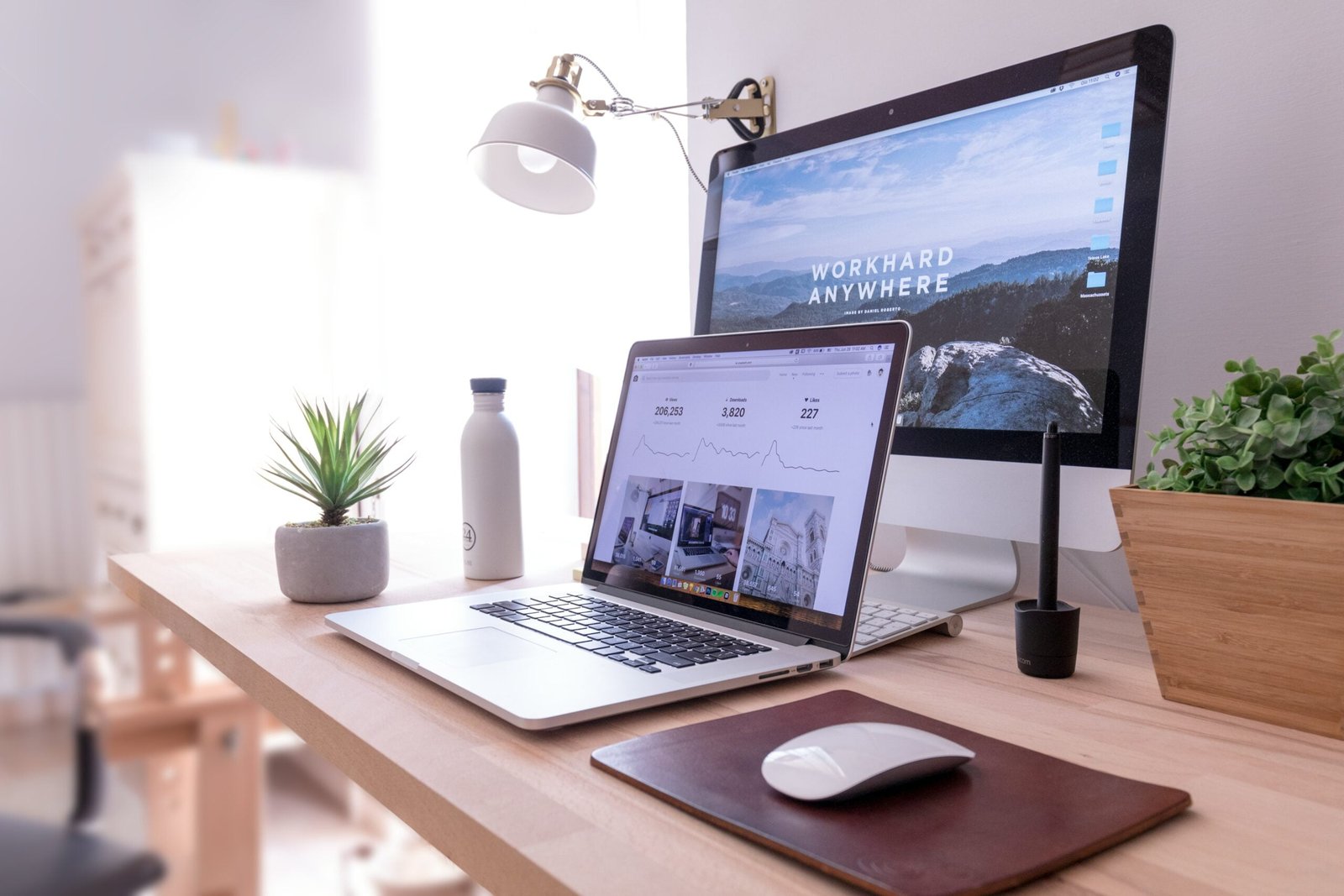Setting Up an Effective Workspace
Creating a dedicated and ergonomic workspace is a crucial step for remote workers to maintain productivity and motivation. Selecting the right furniture, such as an adjustable chair and a desk at an appropriate height, can significantly impact your comfort and efficiency. Ergonomic furniture supports good posture and reduces strain, which is essential for prolonged periods of work. Additionally, investing in a monitor stand or a laptop riser can help align your screen at eye level, minimizing neck and eye strain.
Organizing your desk is another key aspect of setting up an effective workspace. A clutter-free environment can enhance focus techniques and reduce mental stress. Utilize desk organizers, cable management solutions, and storage options to keep your workspace tidy. Keeping essential items within reach and arranging them systematically can save time and prevent distractions. For example, place your most-used tools and documents in easily accessible areas to streamline your workflow.
Minimizing distractions is also vital for maintaining productivity in a remote work setting. Choose a quiet area in your home, away from high-traffic zones and household noise. If possible, invest in noise-cancelling headphones or a white noise machine to block out external sounds. Setting boundaries with family members or housemates can help create a professional atmosphere, ensuring you have uninterrupted work periods.
Beyond the physical setup, the psychological benefits of having a designated work area are substantial. It helps to mentally separate work from personal life, creating a clear boundary that can improve work-life balance. When you step into your dedicated workspace, it signals your brain that it is time to focus on work tasks, enhancing your ability to concentrate. Conversely, leaving this space at the end of the day helps you transition into relaxation mode, preventing work from encroaching on your personal time.
By thoughtfully setting up an effective workspace, remote workers can enhance their time management and maintain a productive remote work routine. A well-designed work environment not only supports physical well-being but also fosters a disciplined and focused mindset.
Establishing a Routine and Sticking to It
Maintaining a consistent daily schedule is paramount for remote workers aiming to enhance productivity. Establishing a routine not only fosters a sense of normalcy but also helps in delineating professional and personal boundaries. A regular start time can act as a psychological cue to transition into work mode, which is crucial when working from home. Setting a fixed time to begin your day ensures that your body and mind are prepared to tackle tasks efficiently.
Incorporating breaks into your schedule is equally important. Breaks serve as essential intervals that prevent burnout and sustain focus throughout the day. The Pomodoro Technique is an effective method that involves working for 25 minutes, followed by a 5-minute break. This technique can enhance your focus and ensure that you are consistently productive without feeling overwhelmed. Over time, these short, structured breaks help in maintaining a high level of efficiency and focus.
Another powerful time management tool is time blocking. This technique involves allocating specific time slots for different tasks throughout the day. By dedicating certain hours to specific activities, you can ensure that each task receives the attention it requires. This method minimizes distractions and prevents the tendency to multitask, which often leads to reduced productivity. Time blocking also provides a clear structure to your day, making it easier to track progress and accomplish goals.
Having a clear end to the workday is just as crucial as the start. Setting a definitive end time helps in creating a boundary between work and personal life, which is vital for mental well-being. It signals to your mind that work is concluded for the day, allowing you to unwind and recharge. This separation can prevent the blurring of lines between professional and personal time, contributing to a healthier work-life balance.
By adhering to these strategies and consistently applying focus techniques, remote workers can establish a routine that not only boosts productivity but also fosters a sustainable and balanced work-from-home lifestyle.
Utilizing Productivity Tools and Apps
In the realm of remote work, leveraging technology is indispensable for maintaining high levels of productivity. Various productivity tools and apps can significantly aid remote workers in staying organized, managing tasks, and communicating effectively with team members. By integrating these tools into daily workflows, remote workers can streamline their work processes and enhance overall efficiency.
One essential category of productivity tools is project management software. Applications like Trello, Asana, and Monday.com offer comprehensive solutions for task allocation, progress tracking, and deadline management. These platforms enable team members to collaborate seamlessly, ensuring everyone is on the same page and project milestones are met timely. They also offer visual representations such as Gantt charts or Kanban boards, which can be particularly beneficial for keeping track of multifaceted projects.
Communication platforms are another critical component for remote work routines. Tools like Slack, Microsoft Teams, and Zoom facilitate real-time communication and virtual meetings, reducing the feeling of isolation often experienced by remote workers. These platforms support text, voice, and video interactions, allowing for versatile communication depending on the needs of the moment. Incorporating these tools into daily work routines can help maintain a sense of community and ensure that important information is disseminated efficiently.
Time-tracking applications, such as Toggl, Harvest, and Clockify, are invaluable for those looking to optimize their time management. These tools help workers monitor how much time they spend on various tasks, providing insights into productivity patterns and identifying areas for improvement. By regularly reviewing these analytics, remote workers can make informed decisions on how to allocate their time more effectively and avoid common pitfalls such as procrastination or task overload.
To seamlessly integrate these tools into daily workflows, it is crucial to start with a clear understanding of one’s specific needs. For instance, a team heavily reliant on asynchronous communication might prioritize robust project management software, while those requiring frequent real-time interactions might lean towards comprehensive communication platforms. Regular training sessions and periodic evaluations can also help in making the best use of these tools, ensuring they contribute positively to productivity rather than becoming additional burdens.
By thoughtfully selecting and integrating productivity tools and apps, remote workers can create a more structured and efficient work environment. This not only enhances individual performance but also fosters a more collaborative and cohesive team dynamic, ultimately leading to greater success in remote work settings.
Prioritizing Self-Care and Mental Well-being
Maintaining mental and physical health is crucial for remote workers aiming to achieve sustained productivity. Regular exercise, proper nutrition, and adequate sleep form the foundation of a healthy routine. Incorporating daily physical activities, such as stretching, walking, or even a home workout session, can significantly enhance focus and reduce stress levels. Balanced meals rich in nutrients further support cognitive function and energy levels, thereby aiding in efficient time management.
Quality sleep cannot be overemphasized. A well-rested mind is more agile, better equipped to tackle challenges, and less prone to errors. Establishing a consistent sleep schedule helps in maintaining circadian rhythms, which positively impacts overall well-being.
Stress management is another critical component of self-care. Remote work routines can blur the lines between professional and personal life, leading to burnout. Allocating specific hours for work and leisure, and taking regular breaks can help in maintaining a healthy work-life balance. Techniques such as mindfulness, meditation, and deep-breathing exercises can be incorporated into daily routines to alleviate stress.
Setting clear boundaries is vital. Communicate your work hours to family members and colleagues to avoid interruptions and ensure focused work time. Additionally, designating a specific workspace within your home can help in mentally separating work from personal life.
Social interactions are equally important. Remote work can often lead to feelings of isolation. Regularly connecting with colleagues through virtual meetings, chats, or even informal virtual coffee breaks can foster a sense of community and support. Engaging in social activities outside of work, such as hobbies or community groups, can also contribute to a balanced and fulfilling life.
By prioritizing self-care and mental well-being, remote workers can enhance their focus techniques, manage time more effectively, and maintain a productive and satisfying remote work experience.



